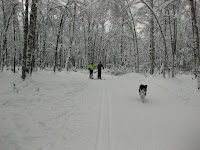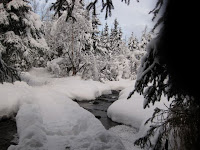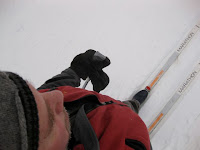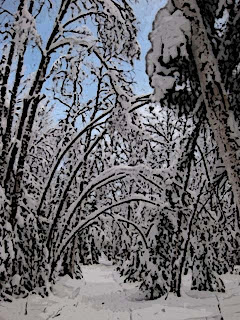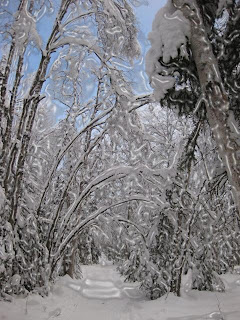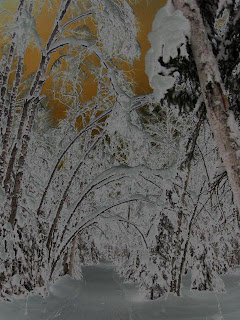[All the wild bear pictures and the runner in the woods picture were taken by my friend Doug while he was visiting this summer.]

In the
Bears, Moose, People Part 1, I discussed the narratives people have in their heads about urban wildlife. In Part 2 I want to discuss the pieces, basically those things that can change or be changed to decrease the likelihood of bad encounters between people and bears.
I see three basic factors:
- People
- Bears
- Land
1. PeoplePeople can change their behaviors:

- Stop attracting bears into urban areas
- no bird feeders in the buffer zone - residential area on the edge of parkland
- bear proof garbage cans in the buffer zone (shared country)
- no raising animals - chickens, goats, rabbits - in the buffer zone
- Limited use of park areas where bears are present
- stop activity that is most likely to provoke confrontations with bears, such as
- activity that increases likelihood of sudden encounters - ie.
- moving quickly through forested areas such as biking, running
- quiet movement through forested areas
- going into areas of bear habitat - spawning salmon runs
2. BearsWe can't change the general behavior of bears.

However,
- we can understand bear behavior and then using that understanding, change our own behavior in ways that will decrease specific bear behaviors. This works for bear behaviors that are affected by human behaviors, like coming into residential neighborhoods because of garbage, dog food, and bird seed.
- protecting particular areas, if deemed necessary, with bear proof barriers. For the most part this is impractical because of the large amount of land in question. This is, however, the logic behind bear proof garbage cans. If there are specific areas where people congregate, such as the Campbell Science Center, where bears could become a problem, there could be raised decks, boardwalks, etc. that would better separate humans and bears.

- remove bears that become problems - relocation or, if necessary, killing problem bears.
3. LandIn abstract terms, we can identify three land areas:
- Bear country - this is the natural area of bears, people enter this area occasionally at their own risk
- Shared country (border zone) - this is area, such as parks on the edge of urban areas, where both people and bears go regularly
- People country - this is urban area, particularly residential, that is primarily the natural area of people, where bears only occasionally enter
The problem here is that different people would put the boundaries at different places on the map. For some, bear country would be at least 50 miles from any road, and shared country would be 25 or more miles from any road. People country would extend as far as anyone could reasonably hike or bike from a trailhead from a road. Others would consider shared country parks on the urban edge.

How people react to the options listed above will depend on the narratives they have about people, bears, and the relationship between people and bears. Let's look at this. (And as I write this, I realize I'm modifying a bit the narratives I outlined in Part 1, or even offering new narratives. Please indulge me on this.)
Narratives about Bears range from:
- Treadwell narratives - bears are really sweet and gentle and if you understand them we can all live in harmony.
to
- Bears are vicious animals and the wild bears should not be anywhere near people
I think the truth probably lies somewhere in between. Bears are not ruthless, vicious creatures, but the are big, powerful, have sharp teeth and claws and in some circumstances can be dangerous to human beings. Those basic dangerous situations have been identified by biologists as:
- protecting their young
- protecting their food
- when startled or otherwise provoked or threatened
Biologists also tell us that bears have different ursanalities ("
personalities" doesn't seem quite the right word) and, like some people, some bears don't follow the general rules of how bears behave.

All the recent bear encounters appear to fit these categories. Bears coming into urban areas seem to be looking for food that people have left out, or in the form of moose or fish. These bears have not attacked people, and those who have not shown fear of humans, have been shot by state biologists or police.
Narratives about People
These are more difficul
t. But let me give it a shot:
- Freedom extremists - These people seem to still be in that childhood stage where they don't think about how their actions affect others. They want to do what they want to do and others be damned. If I want to go riding in the park, well, I should be able to do that without fear of bears. Therefore, get the bears out.
- Extreme anti-risk Parents - Anything that might cause the slightest risk to their children should be banned or removed. (What people consider to be a risk is subjective.)
- Dare-devils - They aren't so interested in getting rid of the bears, but want to be able to take whatever risks they want to take. "If I want to take that risk, what's it to you? I'm not asking you to do it." They may not realize that their behavior may jeopardize the bear by provoking an attack that will cause public reaction to remove or kill the bear. Or that their feeding a bear will cause that bear to approach other people for food.

- The ignorant - They just aren't aware, don't read the rules, act surprised and even indignant if something bad happens. "How was I supposed to know?"
- Basic Rule Followers - these people follow the rules, particularly the ones that make sense to them. They'll buy bear proof garbage cans and read and follow the bear-safety pamphlets.
- Coexistence activists - They moved to Anchorage because of the natural wilderness and are active in protecting the wilderness and animals and promoting safe interaction.
- Bears are our friends utopians - They embrace the coexistence ideal and gloss over the fact that bears can kill. "Why can't well all just live as one happy family?"
- Bear Tyrants - They insist that the loss of any animal life is a crime and that anyone hurt by a bear was at fault.
OK, I'm offering a few extreme examples here and I'm sure I've left out a lot of possible ways people think about this topic, but you get the idea. We don't agree. And we aren't consistent. There may be times when we fit one narrative and other times when we don't.
Whatever rules or guidelines or laws we have about what people should or should not do, there will be people who don't follow the rules. There are also people who will follow the rules, yet still find themselves in dicey situations. Life contains risk. Dogs cause more human deaths in Alaska than do bears. Finding exact stats on this is not easy, but so far this year I'm aware of two children killed by dogs (in
Fort Yukon and in
Anchorage). This
1981 report that says:
Between 1955 and 1980, 14 human deaths from dog attacks were documented in the State of Alaska. In addition, discussions with private physicians, private veterinarians, public health nurses, and sanitarians strongly suggest that at least twice this number of human deaths from dog bites occurred during this 25-year period of time. Of the 14 documented cases, all occurred in children less than 10 years of age.

This
2008 report says
Alaska Report at a Glance:
- Deaths (1991-2002): 9
- Median Age: 54 months
- Age Range: 9 to 64 months
- Circumstances: Three cases of free-roaming dogs, three of chained dogs, one victim wandered into dog lot, one attacked indoors by pet, one unknown
Wikipedia's list of bear deaths in the United States lists 7 human deaths from bears in Alaska in the 1991 - 2002 period. Most of these deaths were in what I have called bear country, though the two hikers at McHugh Creek, within the Municipality limits, were in what could be called shared country. Another death at a cabin near Glenallen might also be called shared country.
I'll try to get up Part III - Conclusions up before too long.
[If anyone can tell me how to fix the gaps around those picture, please do. I know that there is blank picture space blocking the wrap, but that's never happened before with pictures from iphoto.]


 After the Campbell Creek trail ends around Dimond and Victor, we wandered through neighborhoods until we got to Jewel Lake Road and Strawberry. It's been interesting to see when DZ pulls out his camera - generally to get pictures of cars like this one. It turns out I got part of it accidentally while documenting the street. His picture when the car turned left didn't come out.
After the Campbell Creek trail ends around Dimond and Victor, we wandered through neighborhoods until we got to Jewel Lake Road and Strawberry. It's been interesting to see when DZ pulls out his camera - generally to get pictures of cars like this one. It turns out I got part of it accidentally while documenting the street. His picture when the car turned left didn't come out.
 What should you do when you see people this close to moose and starting to get even closer? Last summer I tried to tell my visiting British friend that he was too close (and he was twice as far away as these people) when the moose charged at him and the others next to him. They ran and the moose stopped. When these folks began to walk toward the moose from where they are in the picture, I shouted to stay back, this was a wild animal with a baby. They did back up but when they finally walked on they muttered something to me. One might say it was their choice and the natural consequences would be more effective than anything I might say. But I remember the man who got killed by a moose at UAA after people had harassed it all day. These people might not have been hurt, but there would have been an irritated moose on the trail with lots of Sunday bike and pedestrian traffic going by. Someone else might have been the victim of their foolishness. On the other hand, we don't hear many stories about people getting hurt by moose so maybe I was out of place to interfere. I have to admit this moose looked extremely mellow.
What should you do when you see people this close to moose and starting to get even closer? Last summer I tried to tell my visiting British friend that he was too close (and he was twice as far away as these people) when the moose charged at him and the others next to him. They ran and the moose stopped. When these folks began to walk toward the moose from where they are in the picture, I shouted to stay back, this was a wild animal with a baby. They did back up but when they finally walked on they muttered something to me. One might say it was their choice and the natural consequences would be more effective than anything I might say. But I remember the man who got killed by a moose at UAA after people had harassed it all day. These people might not have been hurt, but there would have been an irritated moose on the trail with lots of Sunday bike and pedestrian traffic going by. Someone else might have been the victim of their foolishness. On the other hand, we don't hear many stories about people getting hurt by moose so maybe I was out of place to interfere. I have to admit this moose looked extremely mellow.

 I'd heard about some new outlet for fish at Westchester Lagoon, but hadn't seen it.
I'd heard about some new outlet for fish at Westchester Lagoon, but hadn't seen it.  This is from a Federal Site where the links don't work right on my Macbook using Firefox, but I tried what I did at the ABC site to find this:
This is from a Federal Site where the links don't work right on my Macbook using Firefox, but I tried what I did at the ABC site to find this:







